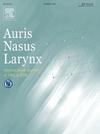Application of intratympanic steroid injection as salvage therapy for idiopathic sudden sensorineural hearing loss
IF 1.5
4区 医学
Q2 OTORHINOLARYNGOLOGY
引用次数: 0
Abstract
Objectives
Although several studies have reported the benefits of intratympanic steroid injection (ISI) in the treatment of idiopathic sudden sensorineural hearing loss (SSHL), its effectiveness remains controversial. The purpose of this study was to evaluate the efficacy of ISI as a salvage therapy for SSHL and identify factors associated with treatment outcomes.
Methods
We retrospectively reviewed the medical records of 119 patients who received systemic steroids for the treatment of SSHL at our hospital between 2014 and 2023. Of the 76 patients who were not complete recovery after systemic administration, 56 were treated using ISI as a salvage therapy.
Results
Among the 76 patients who were not complete recovery after systemic administration, a short period between onset and systemic steroid administration (<4 days) showed favorable treatment effects (p = 0.020). We focused on the 56 patients treated using salvage ISI therapy to evaluate the prognostic factors affecting the efficacy of ISI therapy. The mean hearing loss values were 84.1 dB at the initial visit, 70.7 dB on completion of systemic steroid administration, and 61.8 dB at the final evaluation after ISI. In the univariate analysis, patients who received ISI <23 days after SSHL onset, those who had a hearing loss of ≥60 dB at the initial visit, and those who presented with vertigo at the initial presentation had better hearing recovery with ISI than those who did not (p < 0.01, p = 0.021, and p = 0.052, respectively). Multivariate analysis revealed that a period of <23 days from onset to salvage therapy was independently associated with favorable ISI effects (p = 0.032).
Conclusions
In patients with SSHL, the introduction of salvage ISI therapy <23 days after onset contributes to good hearing recovery. In addition, salvage ISI therapy might be an optional treatment for patients whose hearing loss is ≥60 dB at the initial visit or who present with vertigo at the initial examination.
鼓室内注射类固醇治疗特发性突发性感音神经性听力损失的应用
虽然一些研究报道了鼓室内类固醇注射(ISI)治疗特发性突发性感音神经性听力损失(SSHL)的益处,但其有效性仍存在争议。本研究的目的是评估ISI作为SSHL救救性治疗的疗效,并确定与治疗结果相关的因素。方法回顾性分析我院2014 - 2023年接受全身性类固醇治疗SSHL的119例患者的病历。在76例全身给药后未完全恢复的患者中,56例使用ISI作为补救性治疗。结果76例全身给药后未完全康复的患者中,起病至全身给药间隔较短(4天)的治疗效果较好(p = 0.020)。我们对56例采用补救性ISI治疗的患者进行分析,以评价影响ISI治疗疗效的预后因素。初次就诊时的平均听力损失值为84.1 dB,完成全身类固醇给药时为70.7 dB, ISI后最终评估时为61.8 dB。在单因素分析中,在SSHL发病后23天接受ISI治疗的患者、初次就诊时听力损失≥60 dB的患者以及初次就诊时出现眩晕的患者比未接受ISI治疗的患者听力恢复更好(p <;0.01, p = 0.021, p = 0.052)。多因素分析显示,从开始到挽救治疗的23天与ISI的良好效果独立相关(p = 0.032)。结论SSHL患者在发病后23天采用补救性ISI治疗有助于听力恢复。此外,对于初次就诊时听力损失≥60 dB或初次检查时出现眩晕的患者,补救性ISI治疗可能是一种可选的治疗方法。
本文章由计算机程序翻译,如有差异,请以英文原文为准。
求助全文
约1分钟内获得全文
求助全文
来源期刊

Auris Nasus Larynx
医学-耳鼻喉科学
CiteScore
3.40
自引率
5.90%
发文量
169
审稿时长
30 days
期刊介绍:
The international journal Auris Nasus Larynx provides the opportunity for rapid, carefully reviewed publications concerning the fundamental and clinical aspects of otorhinolaryngology and related fields. This includes otology, neurotology, bronchoesophagology, laryngology, rhinology, allergology, head and neck medicine and oncologic surgery, maxillofacial and plastic surgery, audiology, speech science.
Original papers, short communications and original case reports can be submitted. Reviews on recent developments are invited regularly and Letters to the Editor commenting on papers or any aspect of Auris Nasus Larynx are welcomed.
Founded in 1973 and previously published by the Society for Promotion of International Otorhinolaryngology, the journal is now the official English-language journal of the Oto-Rhino-Laryngological Society of Japan, Inc. The aim of its new international Editorial Board is to make Auris Nasus Larynx an international forum for high quality research and clinical sciences.
 求助内容:
求助内容: 应助结果提醒方式:
应助结果提醒方式:


